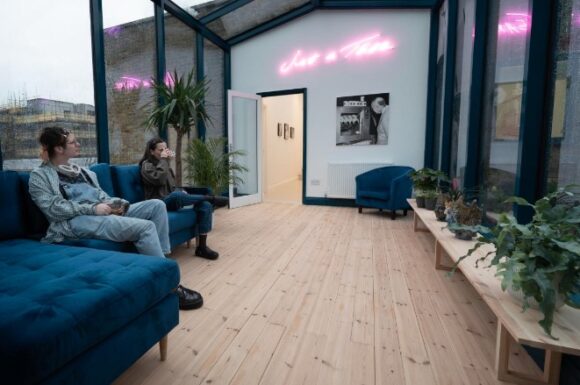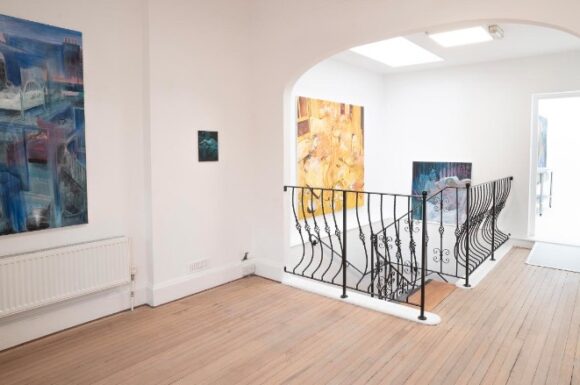
It happens to us all. If we jump enough fences in the Grand National of life we eventually get to the run-in, and there, looming up before us, are the final hurdles. How will I be remembered? What do I leave behind? What was the point of it all?
They’re the kind of questions everyone asks. But if you’re a successful artist who has spent their entire working life in the public eye, whose bank account is bursting with cash, who’s produced hundreds of shows, but no heirs, the run-in is particularly affecting. You’re used to being noticed, yet here you are on the verge of being forgotten. What to do?
One answer is to start furiously clicking the “money” button at the ATM, and begin searching for a location to leave a legacy. Something of that order has clearly happened to two of the most public and noisy artistic presences in the land. Simultaneously, Gilbert & George and Tracey Emin have invested heavily in bricks and mortar, and set about building something pointy for us to notice.

Both the Gilbert & George Centre in the East End of London and the Tracey Emin art school in Margate are gifts to the nation and gifts to the givers. We get the facilities, they get the applause. Both offerings seem to me to be accompanied as well by notes of sadness. Can ambitious building schemes rage against the dying of the light? Damn right they can.
Gilbert is 79. George is 81. For nearly 60 years these two untameable urban sprites have poked, pushed, insulted, annoyed, saddened, angered and disgusted us with their provocative and batty two-person art attack. When they were young, they were up for every fight and loved nothing better than to prod the bear. Now that they’ve reached the run-in, their work has taken on a melancholy flavour.
The mood at their East End Xanadu, located in a former brewery just off Brick Lane — past the curry houses, turn right — is immediately nostalgic and immediately bonkers. The entrance is through a twirly iron gate, hand-forged by the look of it, on which the initials of our new king have been picked out showily in gold.
Earlier on in his own princedom, Charles used to run noisy artistic campaigns against the ugliness and brutalism of modernity. By putting his name on their handmade gate, G&G are reiterating that cause while also annoying the bejesus out of the republicans among us. Typical!
Beyond the gate, there’s a dinky cobbled courtyard, surrounded by a beautifully planted urban garden. And then the old brewery itself, its interior immaculately converted into a suite of gleaming contemporary galleries, arranged on three floors, whose aesthetics have been imported precisely from White Cube land. Thus, the old and the new have been persuaded to snuggle up to each other and get along. Which they do, endearingly.
According to its press release, the purpose of the new centre is to provide “a leading cultural institution in London and a place for research and scholarship on the art of Gilbert & George”. Hilarious. What it actually is, is a location where the limelight-loving twosome can have a perpetual spotlight trained on them, and at which they can keep showing their work. As two aged white men with a chequered political past — remember the Union Jacks, the bovver boots, The Naked Shit Pictures — they are persona non grata on today’s museum circuit, and getting shows has recently proved an issue. Not any more.
The opening event, The Paradisical Pictures, fills all three of the galleries and spills into the corridors. The suite of enormous pictures has a botanical theme and comes in colours lurid enough to sit happily on the cover of a 1960s LP. Haunting the psychedelic flower garden are, of course, G&G themselves. Sometimes full-length and unmissable, in their trademark English gent suits. Sometimes just their eyes, red-rimmed and pulsing, like a wolf’s on a film poster.
Paradise, as G&G explain in a sweet film, is somewhere most faiths believe in. Everyone wants an afterlife filled with flowers. But what if there isn’t one? What if this is all there is?

At first, The Paradisical Pictures appear so bright, so intensely coloured, you suspect them of conveying positive messages about the journey of life. But this is Gilbert & George, and the longer you look, the more doomy it becomes. Most of the leaves are dead. Most of the flowers wilted. Most of the fruit decayed.
One set of pictures deals with dates. In Islam they are the “fruits of paradise”, but here all we see are the stones: chewed, sucked, spat out. The same happens with figs. Leave them lying around uneaten for a couple of days and a psychedelic mould comes surging up. Paradise may be the nominated subject at G&G’s East End Xanadu, but it’s clearly one that’s been lost.
In Margate, Tracey Emin has become a local hero. Having moved back to the town of her childhood, she has built an artistic compound in the centre, with a home and studios, and tangibly uplifted the seaside spirit. Last year, to thank her, they made her a Freewoman of Margate. And for the opening of her art school, she wore the fancy outfit that comes with the title, and treated us to a ceremony filled with music and dance.
It wasn’t just the good people of Margate who were sobbing as they watched the cutting of the ribbon. I went all watery too. Emin, as everyone knows because she has been so public about it, has had bladder cancer. Others might have been bowed by it. She has been prompted. So here she was, bursting with life, shouting happily about turning Margate into “an artists’ haven” and inviting us into her new project.
Converted from a Victorian bathhouse, TKE Studios — after her full name, Tracey Karima Emin — has 30 new work spaces, split between “professional artists” and students. Peppercorn rents mean no one will need to take on a part-time job to keep going. The students pay nothing. Everyone can concentrate on making art.

To find out more, I joined the happy crowd of Margate locals invited in for the official opening, and wandered about the maze of studios looking for artists to interrogate. They were all there, forced by Emin to meet the public in what felt like a toughening-up exercise. They had only been there a month, but already they were having to show their work and explain it.
Grace, who had come from New York, told me about the rules. No smoking, no loud music, no noisy shoes. To ensure the last, she had bought a pair of Crocs.
Jorge, who is from Ecuador, described how Emin had given them a mirror in the first week, and told them to produce self-portraits. In the second week they had to make a film. In the third they were handed a canvas of a specific size and instructed to fill it.

Emmie, from Uganda, saw Emin every day because she was always there, and very hands-on. His studio was encouragingly messy, and the angsty self-portraits hanging on the walls felt immediately authentic. At the Tracey Emin art school there was no time for procrastination or dreaminess. It was action stations from the off.
The student residencies are for 18 months, at the end of which there will be a summary show and a dozen hardened hopefuls will be pushed out into the big bad world, having had the kind of tangible training you just don’t get in today’s art schools.
Driven by commercial considerations, directed by curatorial minds that have lost sight of the joy and power of art, the British art school is an empty husk of what it used to be. Tracey Emin is hoping to change that. Good on her.
The Gilbert & George Centre is at 5a Heneage St, London E1; TEK Studios are at 99 Victoria Road, Margate
